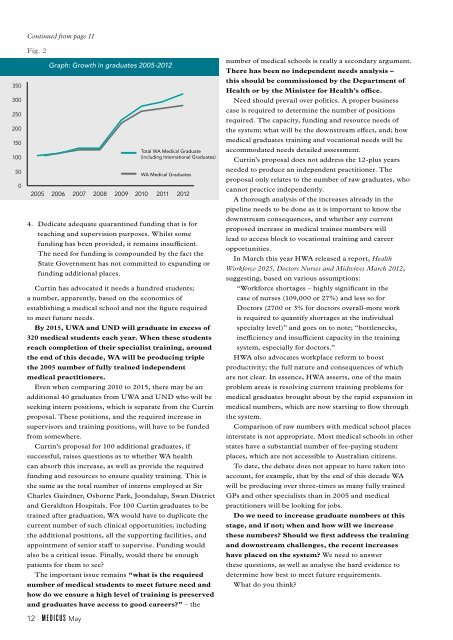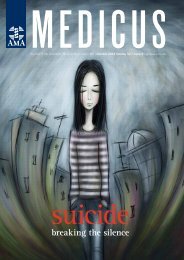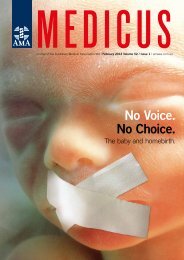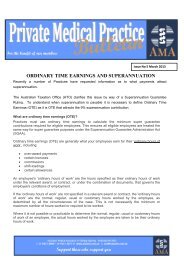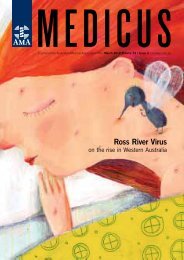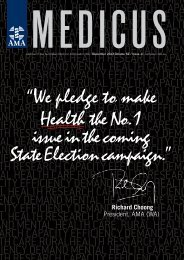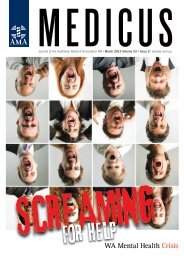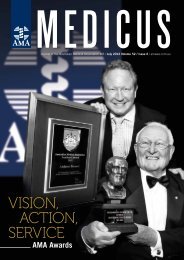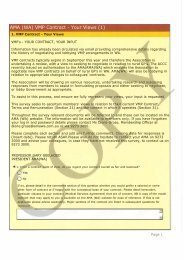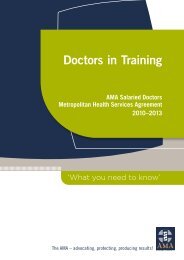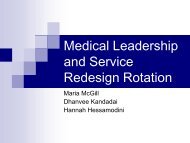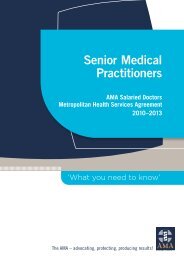Are you ready for the Auditor - AMA WA
Are you ready for the Auditor - AMA WA
Are you ready for the Auditor - AMA WA
Create successful ePaper yourself
Turn your PDF publications into a flip-book with our unique Google optimized e-Paper software.
Continued from page 11<br />
350<br />
300<br />
250<br />
200<br />
150<br />
100<br />
50<br />
0<br />
Fig. 2<br />
Graph: Growth in graduates 2005-2012<br />
Total <strong>WA</strong> Medical Graduate<br />
(including International Graduates)<br />
<strong>WA</strong> Medical Graduates<br />
2005 2006 2007 2008 2009 2010 2011 2012<br />
4. Dedicate adequate quarantined funding that is <strong>for</strong><br />
09 2010teaching 2011 and 2012 supervision purposes. Whilst some<br />
funding has been provided, it remains insufficient.<br />
The need <strong>for</strong> funding is compounded by <strong>the</strong> fact <strong>the</strong><br />
State Government has not committed to expanding or<br />
funding additional places.<br />
Curtin has advocated it needs a hundred students;<br />
a number, apparently, based on <strong>the</strong> economics of<br />
establishing a medical school and not <strong>the</strong> figure required<br />
to meet future needs.<br />
By 2015, U<strong>WA</strong> and UND will graduate in excess of<br />
320 medical students each year. When <strong>the</strong>se students<br />
reach completion of <strong>the</strong>ir specialist training, around<br />
<strong>the</strong> end of this decade, <strong>WA</strong> will be producing triple<br />
<strong>the</strong> 2005 number of fully trained independent<br />
medical practitioners.<br />
Even when comparing 2010 to 2015, <strong>the</strong>re may be an<br />
additional 40 graduates from U<strong>WA</strong> and UND who will be<br />
seeking intern positions, which is separate from <strong>the</strong> Curtin<br />
proposal. These positions, and <strong>the</strong> required increase in<br />
supervisors and training positions, will have to be funded<br />
from somewhere.<br />
Curtin’s proposal <strong>for</strong> 100 additional graduates, if<br />
successful, raises questions as to whe<strong>the</strong>r <strong>WA</strong> health<br />
can absorb this increase, as well as provide <strong>the</strong> required<br />
funding and resources to ensure quality training. This is<br />
<strong>the</strong> same as <strong>the</strong> total number of interns employed at Sir<br />
Charles Gairdner, Osborne Park, Joondalup, Swan District<br />
and Geraldton Hospitals. For 100 Curtin graduates to be<br />
trained after graduation, <strong>WA</strong> would have to duplicate <strong>the</strong><br />
current number of such clinical opportunities; including<br />
<strong>the</strong> additional positions, all <strong>the</strong> supporting facilities, and<br />
appointment of senior staff to supervise. Funding would<br />
also be a critical issue. Finally, would <strong>the</strong>re be enough<br />
patients <strong>for</strong> <strong>the</strong>m to see?<br />
The important issue remains “what is <strong>the</strong> required<br />
number of medical students to meet future need and<br />
how do we ensure a high level of training is preserved<br />
and graduates have access to good careers?” – <strong>the</strong><br />
number of medical schools is really a secondary argument.<br />
There has been no independent needs analysis –<br />
this should be commissioned by <strong>the</strong> Department of<br />
Health or by <strong>the</strong> Minister <strong>for</strong> Health’s office.<br />
Need should prevail over politics. A proper business<br />
case is required to determine <strong>the</strong> number of positions<br />
required. The capacity, funding and resource needs of<br />
<strong>the</strong> system; what will be <strong>the</strong> downstream effect, and; how<br />
Total <strong>WA</strong> Medical Graduate<br />
(including International Graduates)<br />
medical graduates training and vocational needs will be<br />
accommodated <strong>WA</strong> Medical Graduates needs detailed assessment.<br />
Curtin’s proposal does not address <strong>the</strong> 12-plus years<br />
needed to produce an independent practitioner. The<br />
proposal only relates to <strong>the</strong> number of raw graduates, who<br />
cannot practice independently.<br />
A thorough analysis of <strong>the</strong> increases al<strong>ready</strong> in <strong>the</strong><br />
pipeline needs to be done as it is important to know <strong>the</strong><br />
downstream consequences, and whe<strong>the</strong>r any current<br />
proposed increase in medical trainee numbers will<br />
lead to access block to vocational training and career<br />
opportunities.<br />
In March this year H<strong>WA</strong> released a report, Health<br />
Work<strong>for</strong>ce 2025, Doctors Nurses and Midwives March 2012,<br />
suggesting, based on various assumptions:<br />
“Work<strong>for</strong>ce shortages – highly significant in <strong>the</strong><br />
case of nurses (109,000 or 27%) and less so <strong>for</strong><br />
Doctors (2700 or 3% <strong>for</strong> doctors overall-more work<br />
is required to quantify shortages at <strong>the</strong> individual<br />
specialty level)” and goes on to note; “bottlenecks,<br />
inefficiency and insufficient capacity in <strong>the</strong> training<br />
system, especially <strong>for</strong> doctors.”<br />
H<strong>WA</strong> also advocates workplace re<strong>for</strong>m to boost<br />
productivity; <strong>the</strong> full nature and consequences of which<br />
are not clear. In essence, H<strong>WA</strong> asserts, one of <strong>the</strong> main<br />
problem areas is resolving current training problems <strong>for</strong><br />
medical graduates brought about by <strong>the</strong> rapid expansion in<br />
medical numbers, which are now starting to flow through<br />
<strong>the</strong> system.<br />
Comparison of raw numbers with medical school places<br />
interstate is not appropriate. Most medical schools in o<strong>the</strong>r<br />
states have a substantial number of fee-paying student<br />
places, which are not accessible to Australian citizens.<br />
To date, <strong>the</strong> debate does not appear to have taken into<br />
account, <strong>for</strong> example, that by <strong>the</strong> end of this decade <strong>WA</strong><br />
will be producing over three-times as many fully trained<br />
GPs and o<strong>the</strong>r specialists than in 2005 and medical<br />
practitioners will be looking <strong>for</strong> jobs.<br />
Do we need to increase graduate numbers at this<br />
stage, and if not; when and how will we increase<br />
<strong>the</strong>se numbers? Should we first address <strong>the</strong> training<br />
and downstream challenges, <strong>the</strong> recent increases<br />
have placed on <strong>the</strong> system? We need to answer<br />
<strong>the</strong>se questions, as well as analyse <strong>the</strong> hard evidence to<br />
determine how best to meet future requirements.<br />
What do <strong>you</strong> think?<br />
12 MEDICUS May


